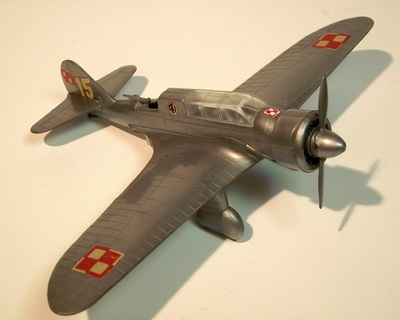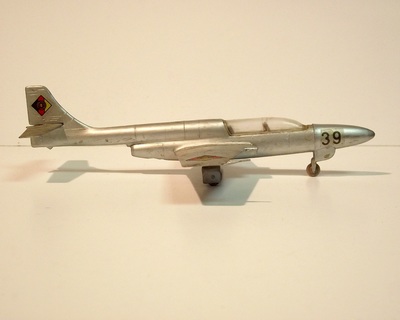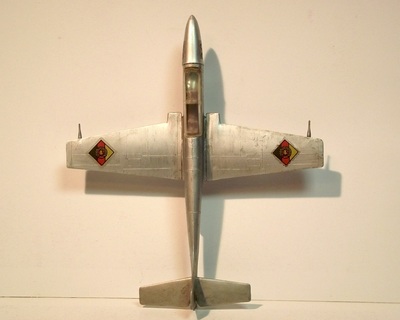PZL P-11C
In reality:
The PZL P-11 was a Polish fighter aircraft, designed in the early 1930s by PZL in Warsaw. It was briefly the most advanced fighter aircraft of its kind in the world. The PZL P-11 served as Poland's primary fighter defence in the Polish campaign of 1939. (Wikipedia)
The model:
Another ZP Ruch Polish scale model from the early 70's this is the PZL P-11C Polish fighter aircraft. It's a simple kit made with Polish military decals. The scale is 1:72
Published May 2015
The PZL P-11 was a Polish fighter aircraft, designed in the early 1930s by PZL in Warsaw. It was briefly the most advanced fighter aircraft of its kind in the world. The PZL P-11 served as Poland's primary fighter defence in the Polish campaign of 1939. (Wikipedia)
The model:
Another ZP Ruch Polish scale model from the early 70's this is the PZL P-11C Polish fighter aircraft. It's a simple kit made with Polish military decals. The scale is 1:72
Published May 2015
PZL P-23A Karas
In reality:
The PZL P-23 Karas was a Polish light bomber and reconnaissance aircraft designed in the mid-1930s by PZL in Warsaw. It was the main Polish bomber and reconnaissance aircraft used during the Invasion of Poland. (The invasion of Poland by Germany, the Soviet Union, and a small Slovak contingent that marked the beginning of World War II in Europe)
The model:
This is 1:72 scale model of the Polish light bomber PZP P-23 Karas. It used very few components and it was assambled in 1975 with Polish Air force decals.
Published January 30, 2015
The PZL P-23 Karas was a Polish light bomber and reconnaissance aircraft designed in the mid-1930s by PZL in Warsaw. It was the main Polish bomber and reconnaissance aircraft used during the Invasion of Poland. (The invasion of Poland by Germany, the Soviet Union, and a small Slovak contingent that marked the beginning of World War II in Europe)
The model:
This is 1:72 scale model of the Polish light bomber PZP P-23 Karas. It used very few components and it was assambled in 1975 with Polish Air force decals.
Published January 30, 2015
PZL TS-11 Iskra
This is the PZL TS-11 Iskra (Spark) plastic scale model kit made in Poland by ZP RUCH. The model was assembled in the mid 70's. From what I remeber there was nothing included with this kit except the plastic moulding parts. In order to make it look like a model airplane (instead of a plastic toy) it was painted in silver using a paint can that was included with a VEB Plasticart model kit. At that time the only decals available were from a VEB Plasticart kit for an East German aircraft. This is not correct as the airplane was never registered in East Germany, it was only used by the air forces of Poland and India as a jet trainer aircraft. Scale 1:72.
Published April 2015
Published April 2015
MIG-15
In reality:
The MIG-15 Mikoyan-Gurevich is a jet fighter from the former Soviet Union introduced in 1949. It had the NATO reprting name "Fagot" and was one of the first successful swept-wing jet fighters. The MIG-15 is believed to have been one of the most widely produced jet aircraft ever.
The MIG-15 Mikoyan-Gurevich is a jet fighter from the former Soviet Union introduced in 1949. It had the NATO reprting name "Fagot" and was one of the first successful swept-wing jet fighters. The MIG-15 is believed to have been one of the most widely produced jet aircraft ever.
The model:
This scale model was built in the late 70's from a Polish plastic scale model kit. It's simple kit that was available with decals for a Polish military aircraft. Scale 1:72
This scale model was built in the late 70's from a Polish plastic scale model kit. It's simple kit that was available with decals for a Polish military aircraft. Scale 1:72
Published January 2015
URSUS - Poland
The only model kit I have from this manufacturer is the Saunders-Roe SR.53 however the box art shows a SU-9 and a PO-2 aircraft as well. The manufacturer, as printed on the box is: Spółdzielnia Rzemieślnicza "URSUS" - Ursus ul. Sowinskiego 21
SAUNDERS-ROE SR.53
In reality:
The Saunders-Roe SR.53 was a British prototype interceptor aircraft of mixed jet and rocket propulsion developed for the Royal Air Force by Saunders-Roe in the early 1950s. Although its performance was promising, the need for such an aircraft was soon overtaken by surface-to-air missile development, consequently the project was cancelled after 56 test flights. Two aircraft were built and flown, one was destroyed during flight testing in June 1958, the first prototype is preserved and on public display at the Royal Air Force Museum Cosford. (source Wikipedia)
The model:
Scale 1:72. Made in Poland in the 1970's. The body of this aircraft was painted in silver with a paint from another VEB Plasticart model. There were no decals in the box so there were used decals for the former Czechoslovak airforce, also from a VEB Plasticart kit. There never existed a Czechoslovak Saunders-Roe of course, but this was the closest available color scheme for the model kit. Remember, this was in the late 1970's and there were limited possibilities for a model builder behind the iron curtain.
Last Update: November 25th 2017
The Saunders-Roe SR.53 was a British prototype interceptor aircraft of mixed jet and rocket propulsion developed for the Royal Air Force by Saunders-Roe in the early 1950s. Although its performance was promising, the need for such an aircraft was soon overtaken by surface-to-air missile development, consequently the project was cancelled after 56 test flights. Two aircraft were built and flown, one was destroyed during flight testing in June 1958, the first prototype is preserved and on public display at the Royal Air Force Museum Cosford. (source Wikipedia)
The model:
Scale 1:72. Made in Poland in the 1970's. The body of this aircraft was painted in silver with a paint from another VEB Plasticart model. There were no decals in the box so there were used decals for the former Czechoslovak airforce, also from a VEB Plasticart kit. There never existed a Czechoslovak Saunders-Roe of course, but this was the closest available color scheme for the model kit. Remember, this was in the late 1970's and there were limited possibilities for a model builder behind the iron curtain.
Last Update: November 25th 2017












































